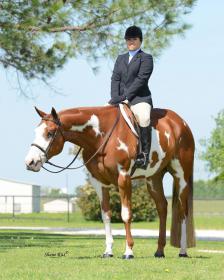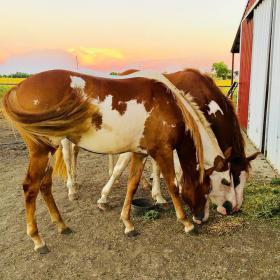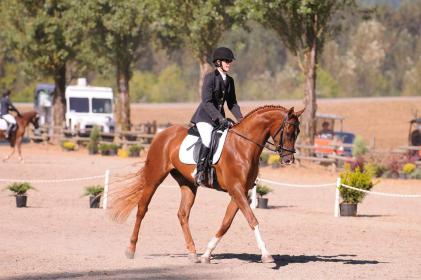I had a chestnut gelding with one sock up front, none behind. Sock ended about two inches above fetlock and was on the left front IIRC. Hoof was mostly white.
my daughter says if they have a white sock they have to have a white hoof
I have a Tb whose only white on the legs is left front coronet, completely white hoof. He has a fair amount of white on the face, including a spot on the lower lip.
I have another horse who has partial coronets with ermine spots and his hooves are striped white and black.
Interesting. My horse has a full blaze and hind stockings, no front leg white markings. The left hind stocking is higher than the right. But he’s an Araloosa, so that throws another factor into the genetic mix. (snowflake blanket w. a couple of spots, some roaning)
As for hoof color, yes, his hind hooves are white, but his front hooves are also white, but with dark vertical striping. Since has no front leg markings of any kind, this is just an expression of an Appaloosa breed characteristic.
A friend’s Oldenberg (Trakhener/Hanoverian - dark bay) has three socks -two behind, one in front (on the right) and his left FRONT pastern is “roaned” - it looks like he tried REALLY HARD to have four pastern height socks, but just couldn’t squeeze out that fourth one! lol
I love that!! Thought the 21 hind/face marked horses in my little sample were super interesting compared to the 4 front/face marked ones! 
BTW, @Arelle there are 4 LF + face and 4 RF + face bay K00 mares. So 13 total front white with no hind white bay mares. That’s more than we have with all four white. Do you consider all four feet white “rare”?
Based on your sample it’s about as rare as front white with no hind white! :winkgrin:
More, actually. 10 to 13. But most wouldn’t consider it particularly rare.
I wondered about this breakfast question as a child, back about 1970, or so, and have been watching in real time for horses with only white front legs (both front, not just one)and dark hinds. Face markings not considered. While it’s not RARE, it is unusual.
Is there a point you’re trying to prove or are you just wanting to argue with me on my definition of “rare” versus your definition of it?
I answered the OP based on my experience and knowledge and you’ve commented and argued and tried to put up statistics to prove me wrong with each post.
I maintain that front white with no hind white is unusual and uncommon in my personal experience and based on what I know about my breed of choice, which is paints and to a larger degree stock breeds in general. I don’t study thoroughbred genetics, thus I don’t have a horse in that fight.
I understand how embryos are formed, I understand the basic genetics and phenotype of white spotting genes common in stock breeds - however, I still can’t tell you how my old show horse is a loudly marked overo with zero white on his hind right - as I’ve said from my first post in this thread - I’m not a scientist, nor do I play one on TV.
[ATTACH=JSON]{“data-align”:“center”,“data-size”:“full”,“title”:“1082025_10100338754684879_1353040133_o.jpg”,“data-attachmentid”:10306662}[/ATTACH]
I also can’t tell you how my overo filly ended up with no white socks, but white leg markings on the front of her cannon bones. Again, I’m not an expert in how DNA structures where pigment lands - I know the basics, and that’s where I weigh in my commentary on a social thread on a forum for horse lovers. Since paint genes in general throw a wrench in white spotting for breeds that don’t want tobiano or overo coloring - arabians, TBs, etc - I kept my original post to general embryonic development and W20 - which IS present in multiple breeds, from drafts to TBs to stock breeds.
[ATTACH=JSON]{“data-align”:“center”,“data-size”:“full”,“title”:“40407555_10102049597581999_6635131887092236288_n.jpg”,“data-attachmentid”:10306663}[/ATTACH]
I know, anecdotally, the only two horses I have with all four legs white (who aren’t tobiano) are the mother and son pair I pictured originally, and I know that comes from the W20 gene.
It’s an interesting topic - I’m sorry that you and I disagree that 6.9% is “rare” and that the difference in 10 and 13 in a sample size of 145 doesn’t qualify as “almost as”. Thanks for your research from JC records; it’s cool information regardless of whether you think it’s uncommon or not!


I have heard that, too.
But how about white with stripes? My grade pony with white socks behind had sort of dark beige hooves with multiple grey stripes. On the other hand, my Welsh pony has four high whites and brilliant white hooves. He is fun to keep clean for the show ring. High maintenance, that one.
I’m looking for your interpretation of actual DATA versus your personal experience and memory from a few select horses. Sure, none of the horses in my barn have front white with no hind white, either, but I don’t take that as an indication that’s it’s rare. And I can tell you that while I’ve eyeballed probably thousands of horses in my lifetime, I don’t have the photographic memory to state how many of those have front white without hind white.
Do you have actual data from APHA to share? Or just your recollection and photos of what stands in your barn?
If the sock has a dark “snip” or patch, the hoof will have a dark line running vertically through it.
There’s a horse at my barn with two high front stockings, a stripe and belly splash. He’s an Oldenburg. It stands out to me, in my experience, as unusual to have fronts only.

It’s a bit rare, but I’ve known a few.
I interpreted the DATA you provided and you’re still bitching. :lol:
APHA doesn’t keep records like the JC does - and the studies that I have seen with DATA don’t keep records like the JC does. APHA records whether a horse is overo, tobiano, or solid - there isn’t even a differentiation between splash, lwo, or a dominant white spotting patterns within their systems. The white studies that I have seen conducted and sat in seminars discussing with the scientists that are conducting them are focused on overall percentage of white versus independent location of white, but did dive into particular spotting alleles. I did a whole outline based on the last seminar, but the DATA is as follows:
N = 351 horses (total sample at random)
- 14.25% - No known spotting allele (RR and SPB horses)
- 33.59% - Overo type alleles
- 11.67% - Splash/Sabino alleles
- 27.91% - Tobiano/Tovero alleles
- 12.53% - Ws-Only alleles
SPB horses, N=84
- 54.76% - No known spotting allele
- 8.33% - Overo spotting allele
- 5.95% - Splash/Sabino allele
- 30.95% - Ws-Only allele
QH Parents of APHA horses (estimated)
- 64.29% - No known spotting allele
- 4.76% - Overo spotting allele
- 3.57% - Splash/Sabino spotting allele
- ? - Ws-Only allele (missed the percentage)
QH x APHA crosses
- 1.8x more solids produced
- 2.4x fewer tobiano patterns produced
What percent of overo horses in the study are “spotted”?
37 of the 351 horses carried an “O” allele only. Of those, 33 were O/N overo, 4 were O/N solid. 87.9% of O/N registered RR horses are due ONLY to the one copy of the “O” allele.
What about…?
SW/N - 20 horses
- 80% overo, 20% solid
W20/N - 40 horses - 42.5% overo, 57.5% solid
Are there new spotting patterns we can’t detect? Of the 351 horses included in this study, only 1 was RR and had no known spotting allele and could not be explained by socks/blaze alone. There were 3 “overo” horses which had no alleles or patterns. (I believe these qualified via socks/blaze - but am not 100% certain)
Sorry, sis. I’m doing the best with what I got - and based on my experience, based on the other people on this thread also weighing in with theirs in agreement that if it’s not rare it’s certainly unusual.
Thanks for the discussion, OP! I want to be at your breakfast table for conversations! 
Don’t sweat it. I tend to agree with you based on my personal experience with tbs - and I can’t even begin to count the thousands I’ve seen. I personally like white fronts with no white hinds, I think it’s cute, so it does catch my attention. But AQHA is the largest breed registry in the world, and more permissive of allowing other breeds to cross, so I would not base assumptions on the US JC statistics. Ultimately, no one is counting socks so we will probably never know how “rare” two white fronts/no hinds is. And of course, we’d have to assign a number to “rare” ie. 5% of the population or whatever.
Interesting topic. Years ago in college I took a graduate level class in entomology. We discussed pattern formation…what turns on and off colors? At that time there was a lot of discussion that of course genetics plays a part but there has to be another component - some kind of protein/hormone gradient system that tells the pigments when to start and stop - how are the patterns on a monarch butterfly determined or the stripes on a tiger. It was fascinating.
What is interesting is that at the same time there was research going on: splitting horse embryos so in essence the two foals were identical twins genetically…however their white markings were neither identical nor mirror images but they both did have white markings. So genetics yes but there is more to it.
I’d usually agree but my gelding has three short socks, lots of ermine, and totally black hooves.
